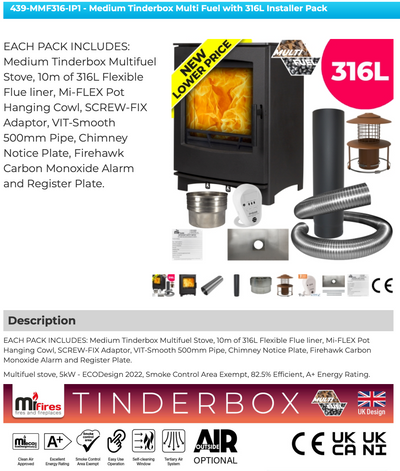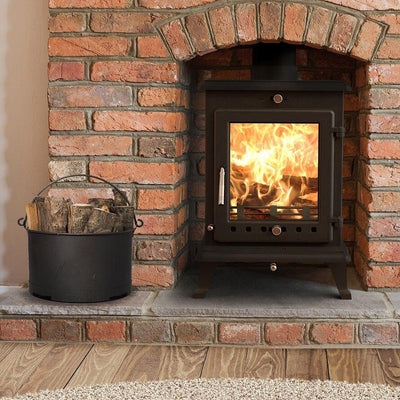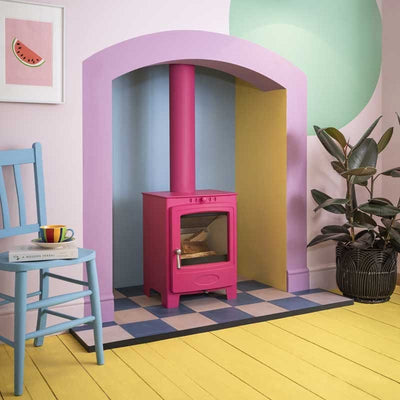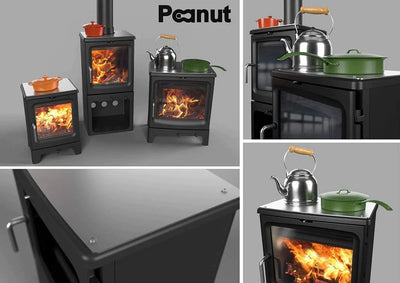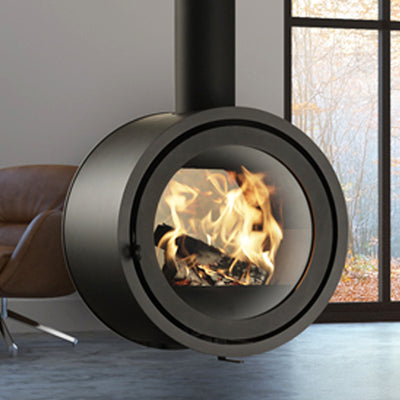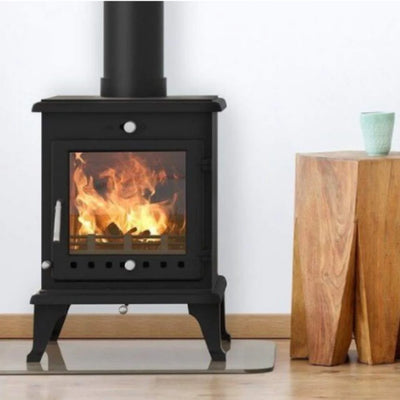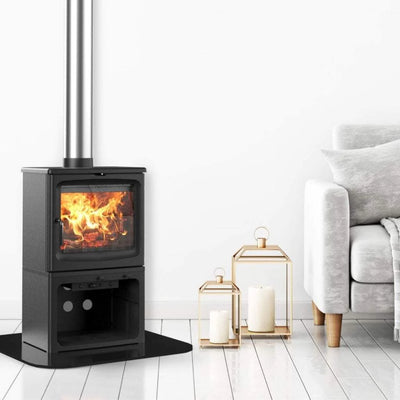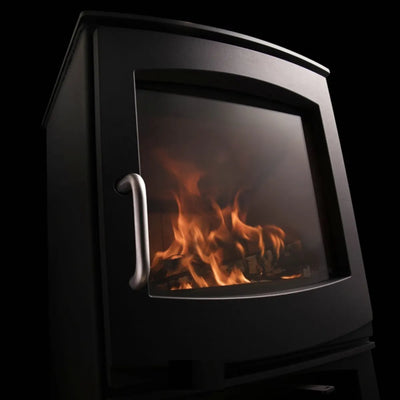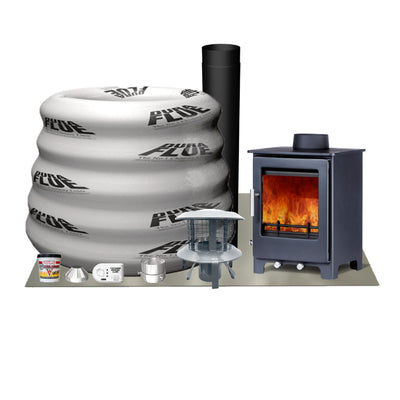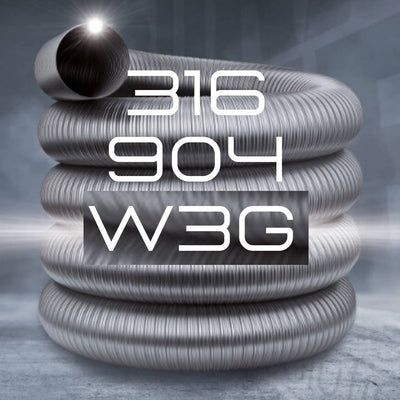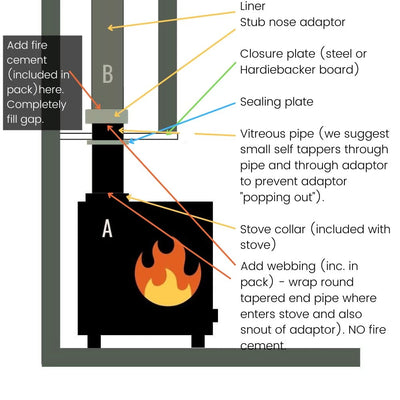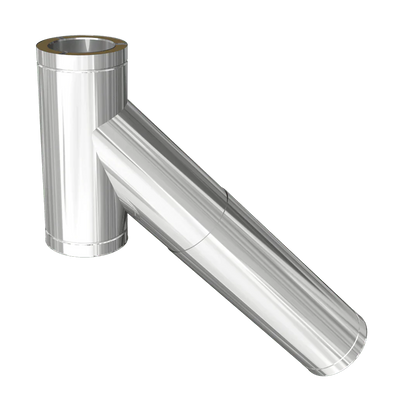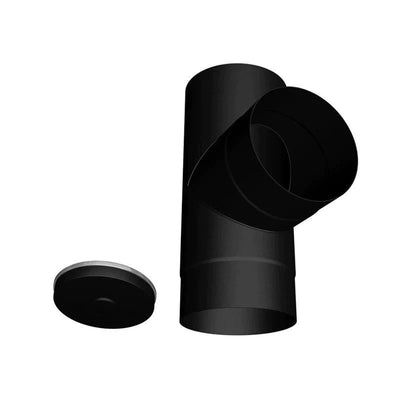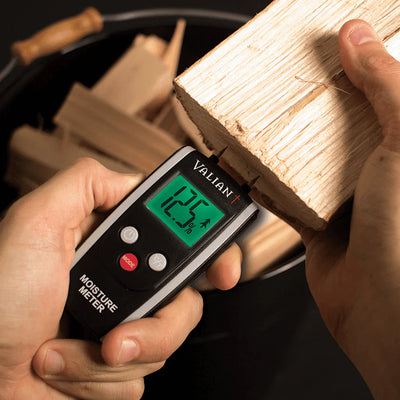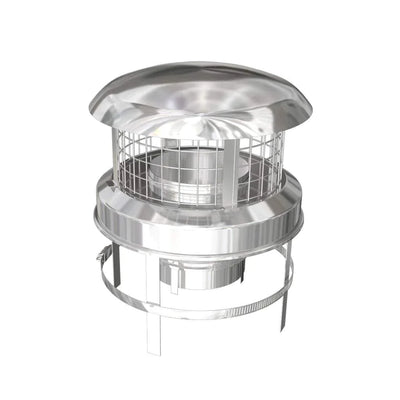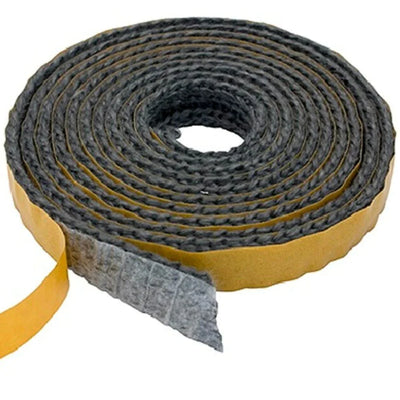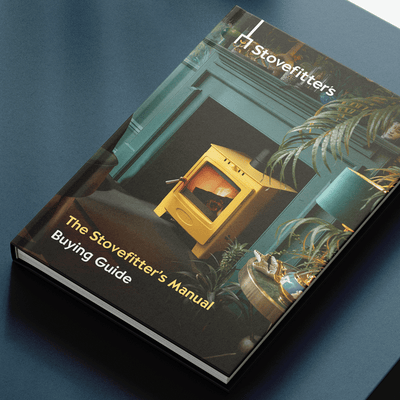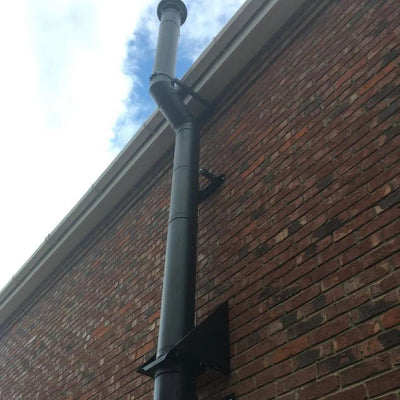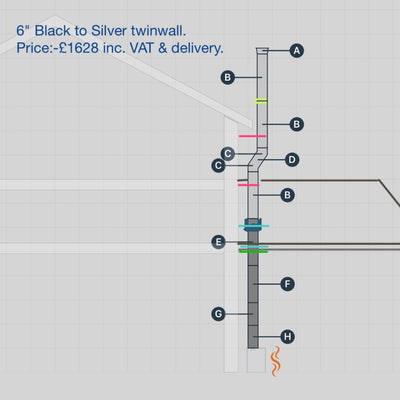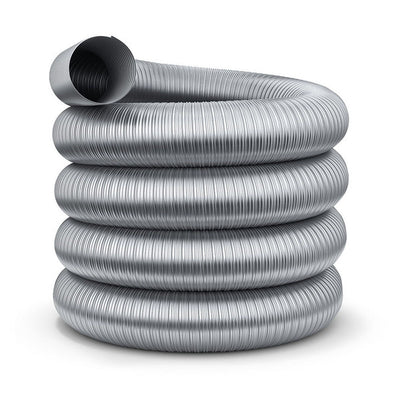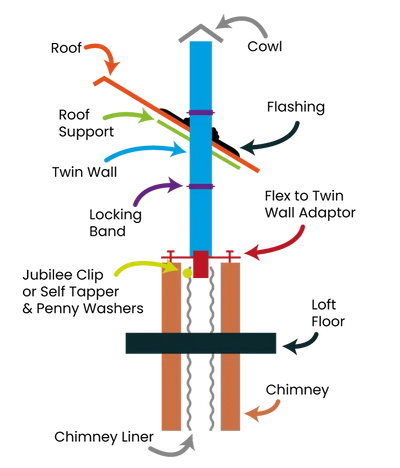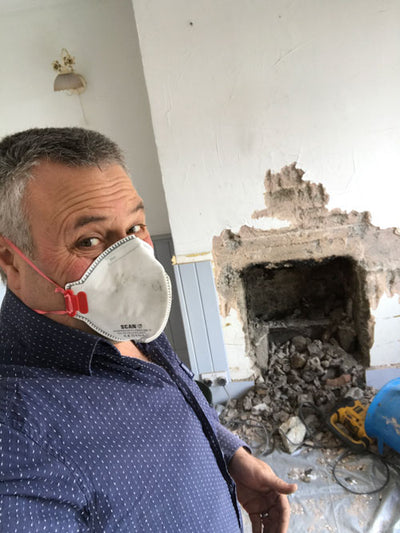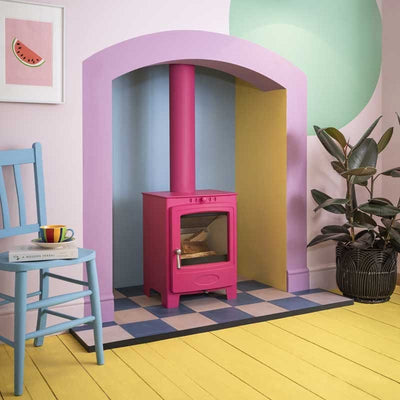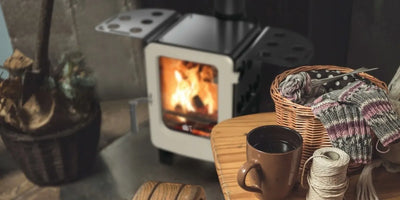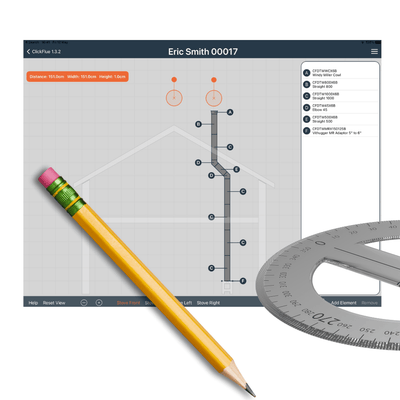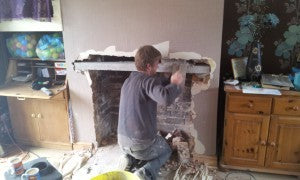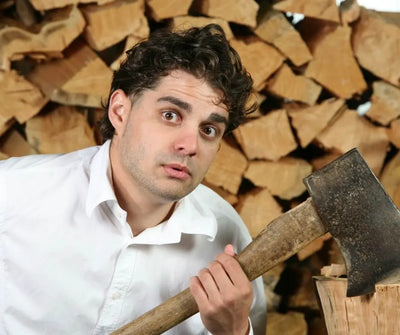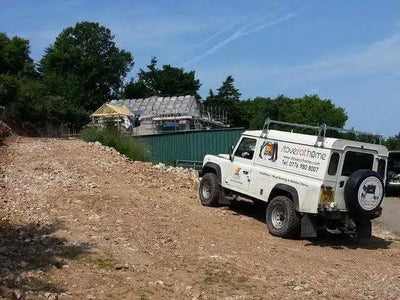What air gap around do I need to leave around a wood burning stove
5 mins
What air gap around do I need to leave around a wood burning stove

Air gaps and wood stoves
Wood Burning Stoves require air gaps around them (sides, rear, top) so the heat can make it into the room.
Air gaps are not a safety issue if there are no combustible materials present. Air gaps are sometimes specified in stove instruction manuals but often are not. Sometimes they are “recommended”. Usually recommendations for distances to non-combustibles are between 5cm and 15cm. To combustible materials we are looking at far more (often 40-80cm).
For this article we focus on distances to NON-combustibles (distances to COMBUSTIBLES can nearly always be found in stove installation manuals).
So let’s find out more about the required air gap around a wood burning stove . . .
Stove manufacturer’s usually request a certain air gap around wood burning stoves, to non-combustible materials (not to be confused with combustible materials), left and right: usually between 2″ (50mm) and 6″ (150mm). This recommended distance is often in the fitting instructions and not in the advertising brochure (so download the fitting instructions to find out – e.g. Google Saltfire ST2 Fitting Instructions or Manual). For this reason you do not want to buy your stove before you know the size of your fireplace recess.
This air gap is there for one reason: to ensure that the heat from the stove gets to the room and is not just heating up the inside of the recess. The manufacturer does not want you ringing up and saying you “paid all this money for a stove and the wife says she’s “colder than a Penguin’s knapsack”.
There is no building regulation involved here: a stove can go as close to a brick wall as you like as long as there are no combustible materials around (as an example inset stoves almost touch or do touch the brickwork so, obviously, there can be no safety issue). You cannot overheat brick or stone.
Manufacturer’s instructions override Building Regulations but only if it is a safety issue. However, some Building Control Officers treat manufacturer’s “recommended” instruction manuals as sacrosanct so be careful.
Wood Burner Clearance Guidelines

Wood Burner Clearance Guidelines
If the air gaps are not as much as you require then you might choose to “bring the stove out into the room a little” to compensate.
One way of bringing a stove a little further into a room is two elbows on top of the stove – to create an offset that moves the stove away from the back wall. Contrary to what some may say you CAN fit two offset elbows directly to the top of a stove (chimney manufacturer’s often recommend a 60cm vertical flue before you change direction but this is only a recommendation and not biding if your recess is not high enough).
You can achieve approx. 8-12cm offset using two 30 degree or 45 degree elbows. This might mean a lintel needs to be raised to fit everything in and ensure the vertical part of the top elbow passes through any chimney closure plate making the seal easier to deal with – being a round hole rather than an ellipse).
See part three of our Beginner’s Guide.
See our shed garage small building chimney kits
This page is about Building Control, Hetas and Permissions. CLICK HERE for regulations regarding distances from combustible materials, heatshields etc.
Other options for fitting into a recess
Another way of fitting a stove in a recess that is bit tight is to choose a stove with a “sweepable through stove” 45 degree rear connector (shown below). This brings the stove further into the room. A 45 rear adaptor allows sweeping through the stove (very few stoves have such a feature but Charnwood stoves have this part as an optional extra).
You might also have seen a sweepable 90 degree “T” off of the rear of a stove and this is also a method one might choose – but only if you have plenty of gap (at least 30cm) to the side of your stove so the sweep can get in to use it (sweeping via the stove is not allowed/possible if the bend behind the stove is more than 45 degrees). Note that a “90 degree bend without a soot door” off the rear is forbidden as a small soot-fall may restrict or block the flue at the bend (and 2x 45 degree elbows = 90 so you cannot cheat by using 45’s).
Elbow offsets, rear sweepable adaptors and 90 degree T’s all result in a good part of the stove being in the room rather than the recess and there is less issue with the heat not getting to the room. I would happily offer this solution to a customer as long as a customer is happy that the manufacturer’s “recommended” instructions re air gaps at the sides have been compromised and the issue has been fully discussed. A part of the stove might have a 4″ rather than 6″ side air gap, but the stove is now part outside the recess, and we are using common sense here and there is no reason for any concern whatsoever.
Now some stoves only request a 2 or 3″ side air gap and some make no recommendation whatsoever (so it is up to you and any inspector). Convector stoves are sometimes worth considering. These are twin skinned so the outside of the stop does not get quite so hot (the heat comes from the glass and air vents at the top of the stove) and therefore a manufacturer might specify a smaller side air gap (a decent gap above the stove might then be a good idea). Don’t get hooked up on convector stoves though – just a stove like any other but the sides get very hot rather than very, very hot.

All methods in our stove and liner fitting packs infographic.
Air gaps to non-combustibles behind stoves? 2″ absolute minimum but 3″ is our minimum recommended and more if you can get it. But check those manufacturer’s instructions.
Air gaps to non-combustibles above stoves? 10cm minimum. Strive for 20cm. You need 35cm minimum between top of stove and chimney closure plate if fitting two offset elbows or a pipe with a soot door (soot door only required if you cannot sweep through the stove for some strange reason).
Lining a recess with 12mm thick Hardiebacker board? Allow for minimum 4″ air gaps if lining the recess with Hardiebacker board to ensure it does not crack with the heat (5″ or more if you can get it).
Air gap above your logburner
BS1251 (a British Standard) says
3.1.4 – Wooden Mantels
“Where a fireplace consists of a marble, stone or ceramic back panel and hearth together with a wooden mantelpiece. There shall be a clearance to combustible material of 300 mm above the fire opening and 150 mm either side of the fire opening to the start of the wooden mantel. Extra clearance may be needed when the fireplace is constructed for certain types of appliance”
This advice therefore should be followed as ‘good practice’ in lieu of no other directive.
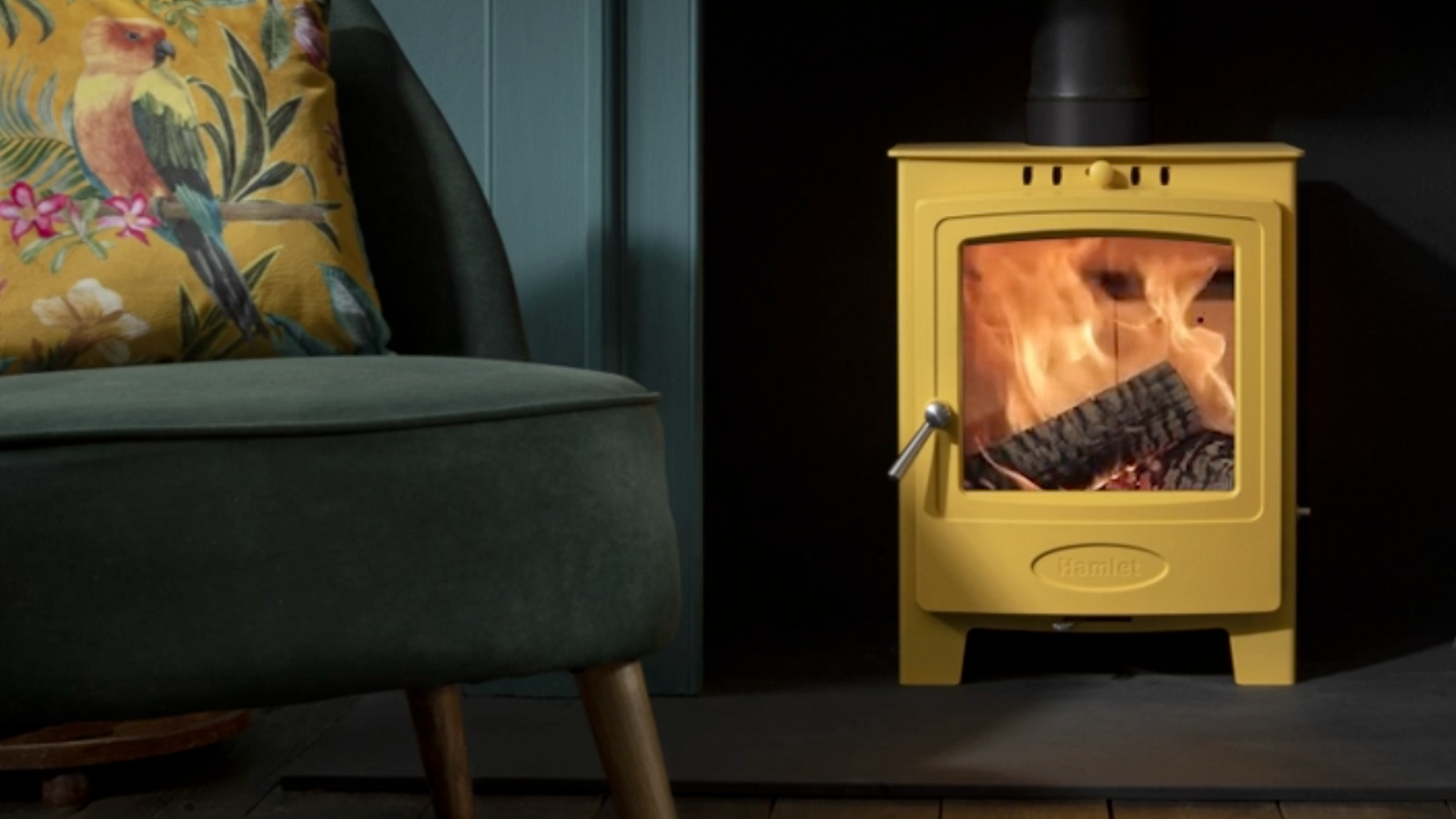
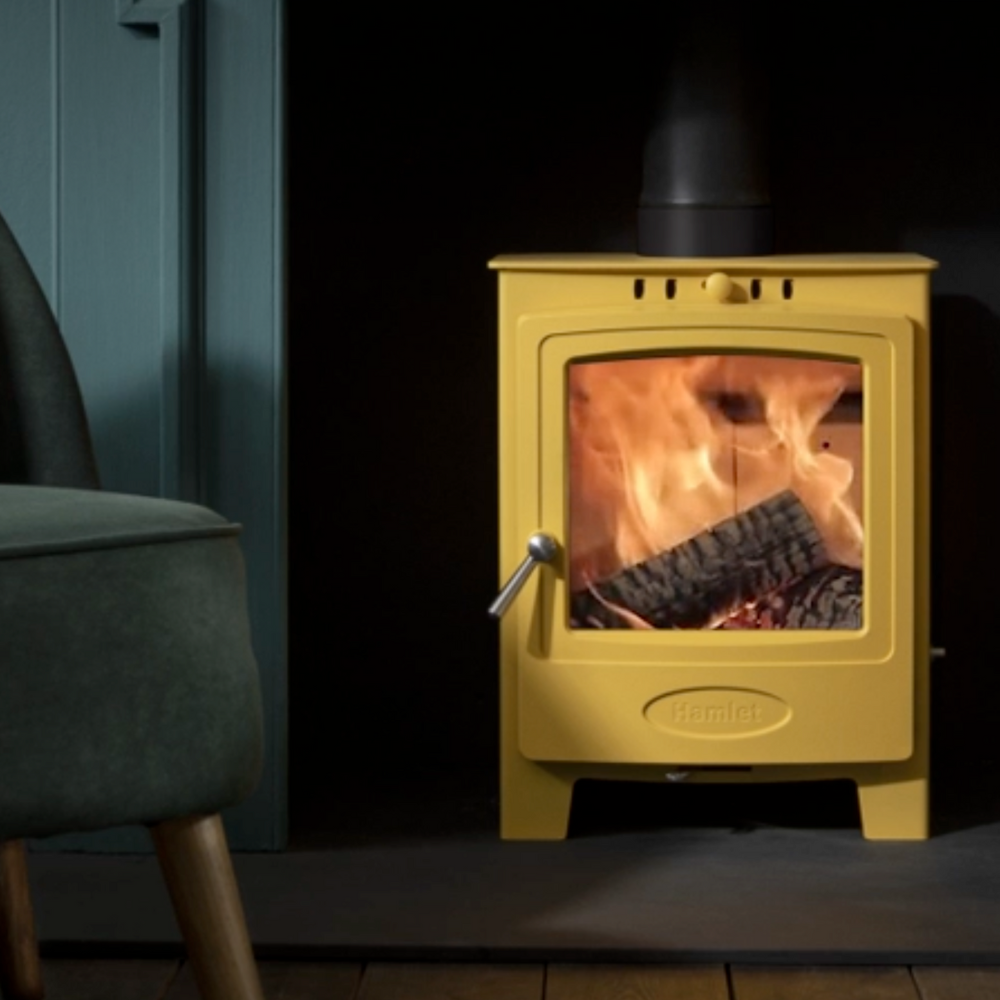
How to choose chimney liner & how much to buy


Installing a stove in a fireplace - what do I need?
FAQs
See all FAQsCosts correct as of April 2023:
Approx. costs if you have a chimney and fireplace ready to use: £750-£1,000 (save £500 by self-installing).
Approx. costs if you have a chimney but need the fireplace "opening up": £1,600-£2,200 (save £1200 by self-installing).
Approx. costs if you do not have a chimney and need a clip-together flue: Shed £475-£700. Bungalow £1500. 2-storey house £2500. Save £1,000-£1400 by self-installing.
Above figures include labour and materials but no appliance.
We, of course, advise you to purchase your stove and materials from Stovefitter's to ensure quality goods are installed (some installers use budget materials to increase margin). If you buy your stove from us (rather than your local small shop or installer) we have a lot more power when approaching manufacturer's with a warranty issue. Why is that? Because we buy many hundreds of stoves a year from these brands.
We do not fit stoves.
But we know a few who do!
Google: Hetas installers
Hetas are the trade body of registered UK installers.
Most installations will require that you slide a chimney liner down your chimney (flexible metal tube 5" or 6" in diameter). Do you have a narrow chimney and want to lessen the risk that a liner might not go down your chimney? Then make sure your chosen stove can use a 5" liner.
Must I line my chimney? Best read this article but most likely the answer is yes. Do I have to fit a chimney liner?
DEFRA-Exempt wood burning stoves with a 5″ collar can usually be fitted to a five inch liner rather than the usual 6″ minimum, making the installer's job much less stressful.
ALL OF THE 5KW STOVES WE SELL CAN BE FITTED TO A 5" CHIMNEY LINER.
I seriously suggest any self installer fits a 5" liner unless they know their chimney is large enough for a 6"!
What is the best chimney liner? Silvacore 904 (we sell it so of course we will say that ;-). What is the best chimney liner?
Useful links
Will your stove require an air vent within the room (some stone walls are very difficult to drill)?
5kW or under and wood burning stoves often do not require an air vent (new builds always require an air vent).
Useful links
What is the maximum output in kW of your "5kW" wood burning stove? The majority of manufacturers just specify the “nominal output” and this figure means very little in real life. The nominal is a figure the manufacturer chooses to sell the stove at - the stove is capable of reaching at least this output with one fuel load. Nominal means "capable of". But it is not the maximum.
Check out the size of the area where the logs will go (firebox size) as this varies enormously. The kW output is completely dependant on the amount of logs burning at any one time - more logs burning equals more heat. If you can fit three logs in stove A and just two logs in stove B then stove A will be capable of throwing out 33% more heat.
DO NOT TRUST MANUFACTURERS’ kW RATINGS as manufacturers specify what output they desire to sell the stove at and testing allows for much “playing with the figures”. This is why you can get very small 5kW stoves (e.g. Aga Little Wenlock) and very large 5kW stoves (e.g. DG Ivar 5 by Dik Geurts which is actually rated 5kW but has a MUCH larger firebox than the Ekol Crystal 5 by Ekol Stoves). A Crystal 5k might get to 5kW and not be capable of any higher whilst a DG Ivar, despite being rated at 5kW, can get to 8kW with a full fuel load.
Note that, over time, one might damage the internal firebricks of a stove by running at a higher load than the manufacturer's suggest. Firebricks are easily replaceable.
Useful links
Will your wood burning stove fit in your recess WITH the required air gaps around it? This is obviously not an issue if your stove will be freestanding.
Air gaps to non-combustible materials (brick, stone etc.) are usually "as close as you like" legally but manufacturers will sometimes specify a recommendation. This recommendation is there to allow heat to escape from the recess into the room - so you get the heat benefit rather than the heat soaking into the building structure and being lost. If no gap to non-combustibles recommended then we suggest 50-100mm air gap left and right of stove, 50mm behind and 100mm above.
Are you in a Smoke Control Area (usually built up areas)?
Choose your stove accordingly.
A stove must be DEFRA-Approved if you wish to burn wood in a smoke control area.
ALL OF THE STOVES WE SELL ARE DEFRA APPROVED FOR SMOKE CONTROL AREAS.
In simple terms if a stove has an efficiency rating of 70% then 30% of the heat from your logs goes up the chimney.
If a stove has an efficiency rating of 90% then only 10% goes up the chimney.
So think of this in terms of how many logs you have to chop/buy.
Example: A Saltfire Peanut 5 by Saltfire Stoves in Dorset has an efficiciency of 80%.
A tall chimney (6m or more) that is lined will be happy with an efficient stove.
Efficiency importance can be said to be overrated and anything between 75% and 85% is fine. Go much higher and performance can actually suffer (smoke in room when opening door to reload, blackening of glass).
Many modern stoves can go on 12mm thick hearths. Others require full, 5″ thick constructional hearths. All of the stoves we sell state whether or not a 12mm hearth is suitable.More about hearths for wood stoves here.
Helpful links
Can you can talk to somebody on the phone should you need to after the wood burning stove has been delivered, especially if you are self installing? Will the staff at “wesellzillionsofstoves.com” be able to assist with any installation issues? What if there are any problems after install?
Do yourself a favour before ordering stoves or materials on the Internet: Go to Trustpilot and type in the company name before you buy. Some companies advertising at the top of search engines are not good news - check for yourself.
When striving to find thebest 5kW wood burning stovesyou will likely be bewildered by the choice. There are many to choose from. The question I get asked most in our shop is “why should I pay <£1,000> for this one when this other one is just <£500>?”. Here is the very simple answer:the cheaper wood stoves are made in Chinaor Eastern Europe whilst the more expensive are made in Western Europe (or sometimes the USA). Here are a few examples where a more expensive stove might excel over a cheaper stove:
- Aesthetics (more time spent on design)
- Hinges (sometimes hidden on more expensive stoves)
- Better quality glass
- Thicker steel (longer life)
- Improved door locking mechanisms
- Longer warranty
- Improved controllabilty of flame due to more resource invested on design of air flow within stove
- Brushed steel fittings instead of cheapy chrome look
Open and close the door on a cheap Chinese stove. Then open and close the door on a DG stove, Arada stoves, Woodford stoves, Hamlet stoves or Saltfire stoves. You’ll understand the difference.
Stove pricing reminds me of wine pricing. A £20 bottle of wine is not double the quality of a £10 bottle of wine (the drinking experience might be improved by 20% as an example). We are talking “the law of diminishing returns here. They are all “fire in a metal box” at the end of the day.
Terminology
View all TerminologyA stainless steel tube, slides down a brick/stone chimney to provide a smooth and safe route for smoke.
All of our stoves are approved by DEFRA to burn wood in all UK locations including Smoke Control Areas (towns and cities). Not all stoves are, so be careful if buying elsewhere.
All of our stoves are ECODESIGN approved to be sold in the UK. Not all stoves are, so be careful if buying elsewhere. ECODESIGN is mandatory by law since January 2022.
The base your stove sits on.
If the chimney is the polo mint then the flue is the hole.
More buying guides
View All
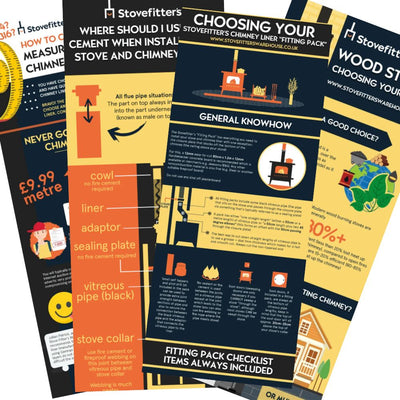
How to choose a wood burning stove for your property (includes infographic)
Infographics

What size wood stove do I need? Don't let manufacturers fool you!
Buying Guides
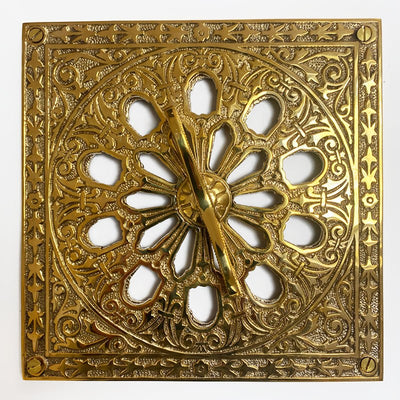
Do I need an air vent for a wood burning stove? If I do not bother?
Buying & DIY

Knowledge Tree: Process of buying and installing a wood burning stove
Buying & DIY
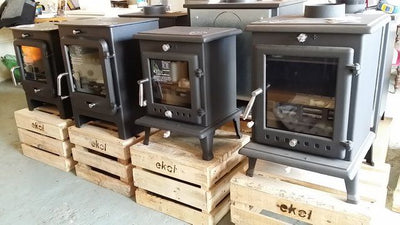
Chinese wood burners – should I buy one or are they all crap?
Buying Guides

What else do I need to buy to install a wood burning stove?
DIY Guides

Infographics for wood burning stove purchase and install
Infographics
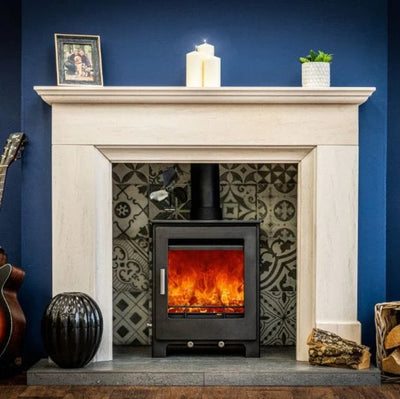
Wood burning or multifuel stove? A stove fitter decides.
Buying Guides
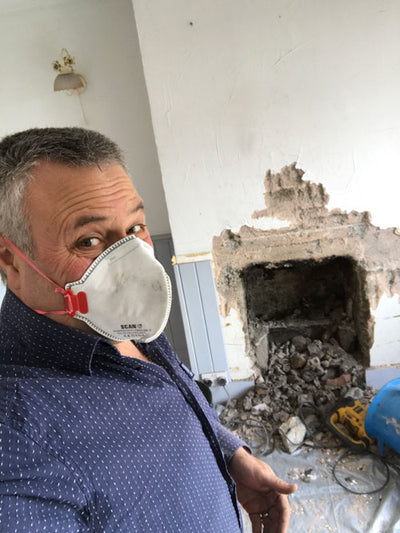
A few words from Julian
Buying & DIY
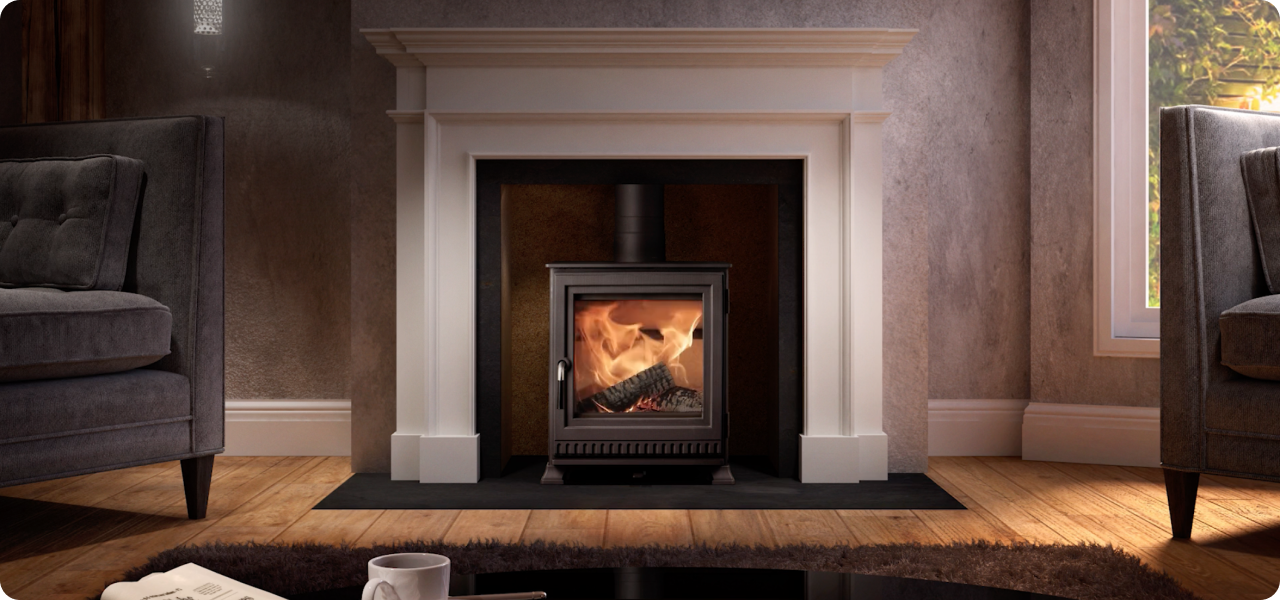
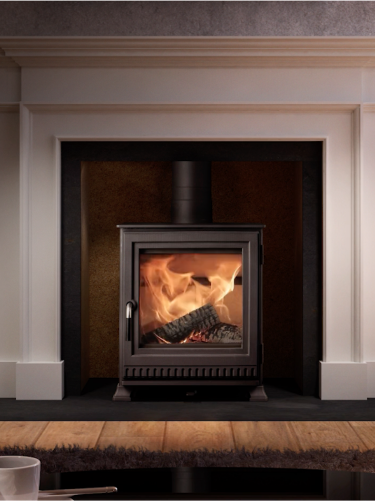
Find my perfect stove
Answer 3 simple questions and we will show you the best Stoves for your space.


